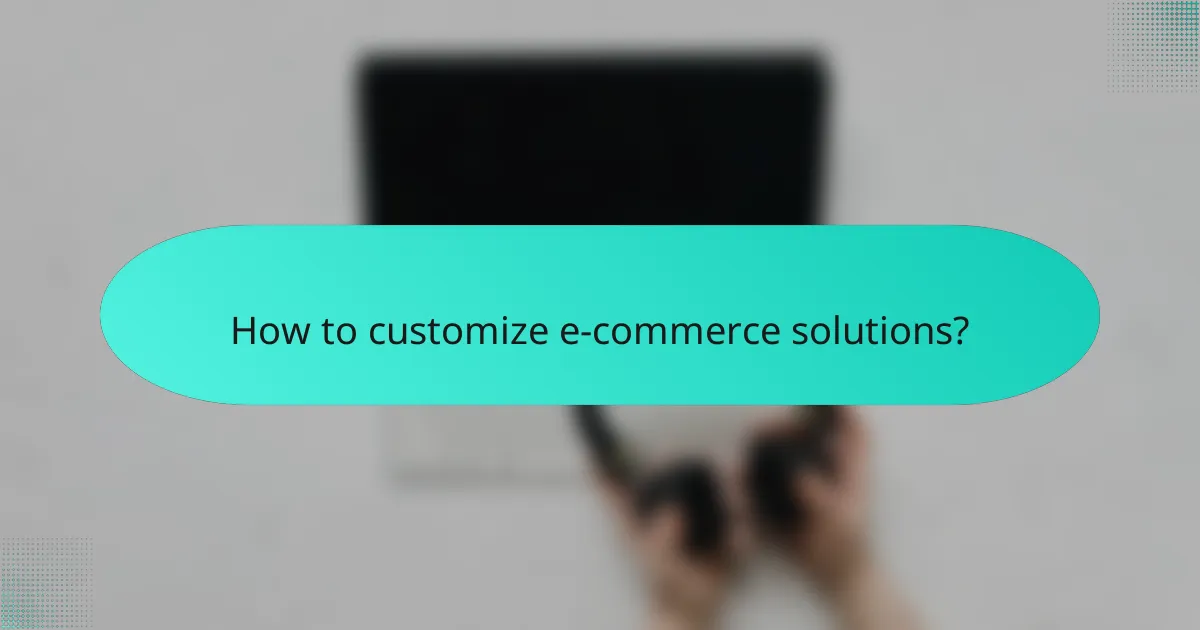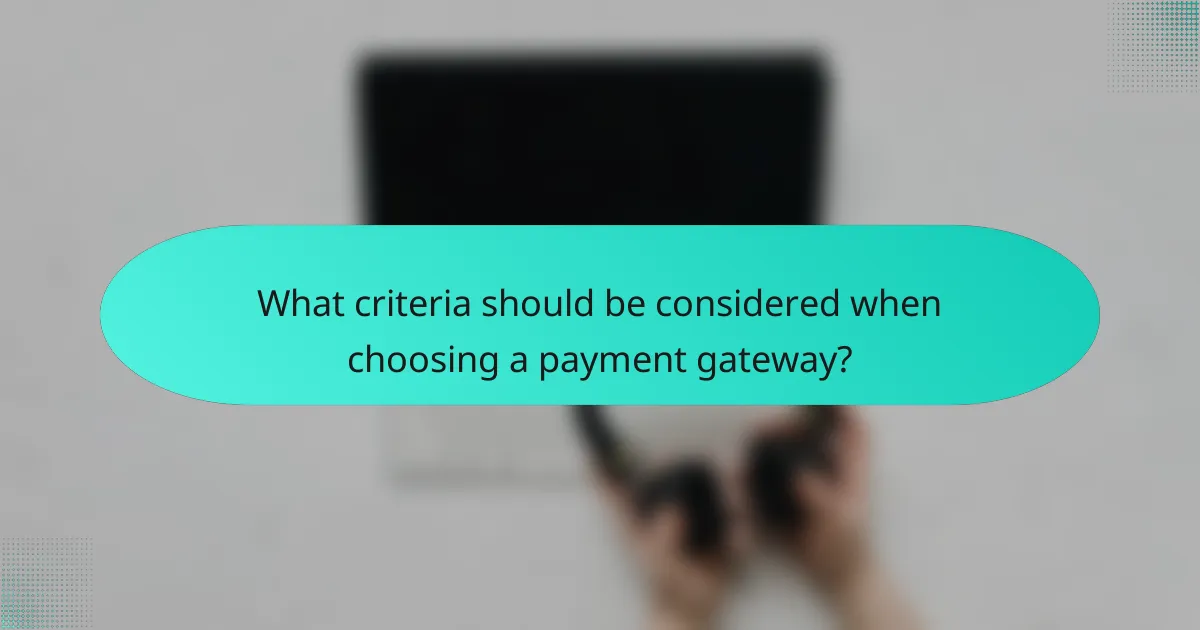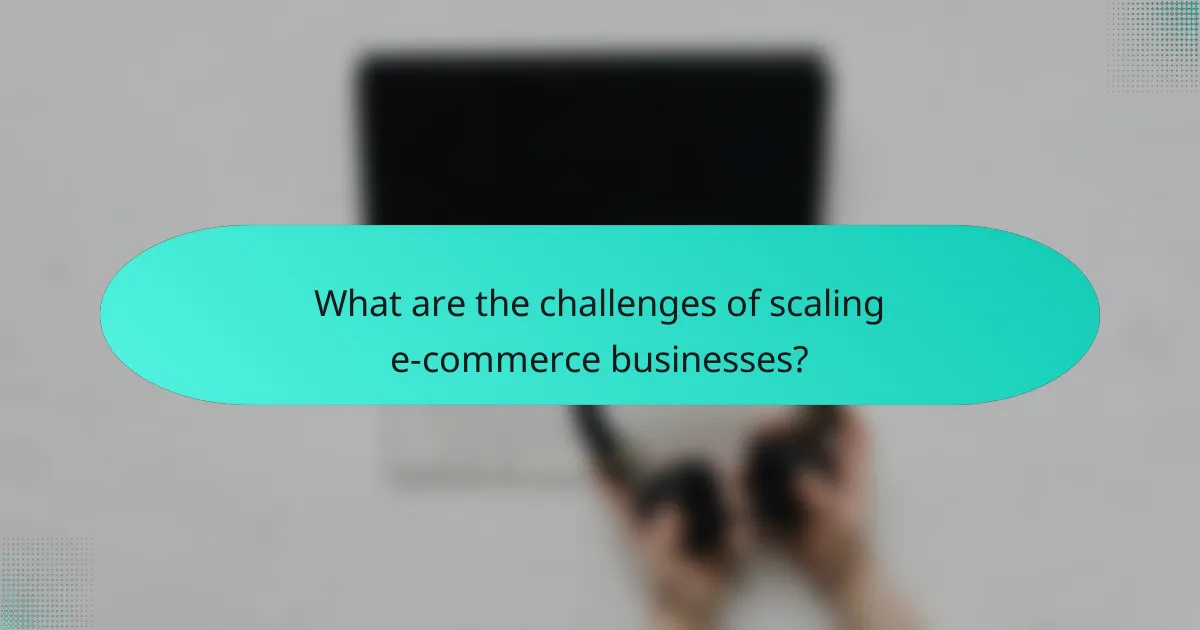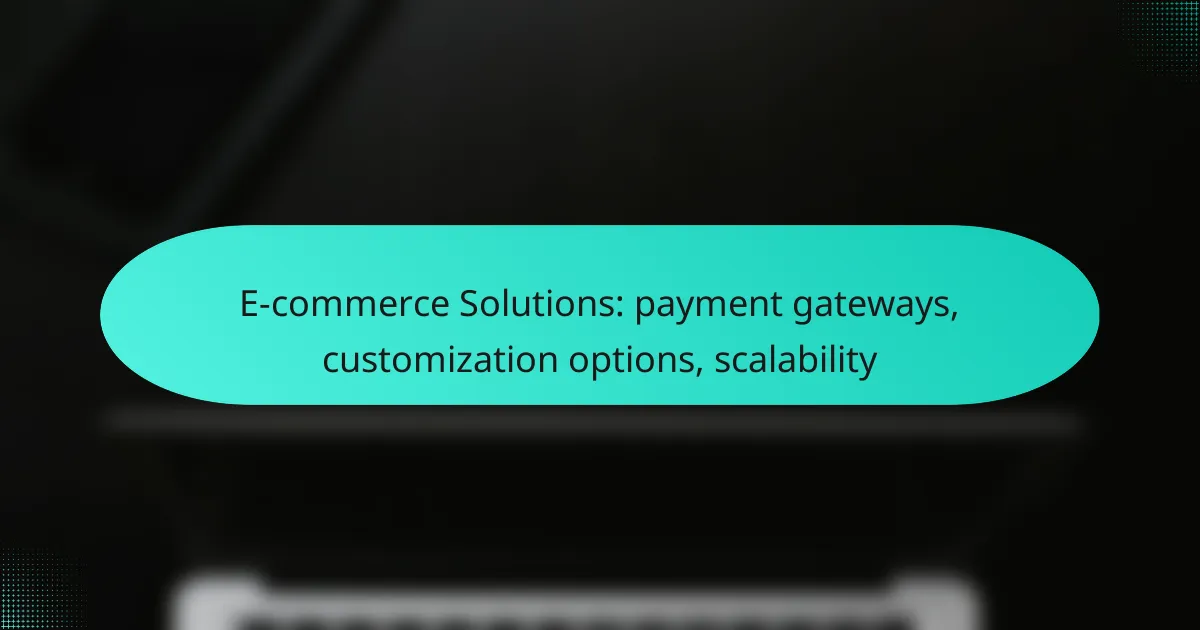E-commerce solutions are essential for businesses looking to thrive in the digital marketplace, with payment gateways playing a crucial role in ensuring secure and seamless transactions. Customization options allow businesses to tailor their online presence, enhancing user experience through personalized themes and streamlined checkout processes. Additionally, scalability is vital for accommodating growth, with various strategies available to manage increased traffic and optimize performance.

What are the best payment gateways for e-commerce in Canada?
In Canada, the best payment gateways for e-commerce include options that offer security, ease of use, and integration capabilities. Popular choices like PayPal, Stripe, Square, Authorize.Net, and Moneris cater to various business needs and customer preferences.
PayPal
PayPal is one of the most recognized payment gateways, known for its user-friendly interface and widespread acceptance. It allows merchants to accept payments via credit cards, debit cards, and PayPal accounts, making it convenient for customers.
Businesses can easily integrate PayPal into their e-commerce platforms, and it offers features like invoicing and subscription billing. However, transaction fees can be higher compared to some other gateways, so it’s essential to consider these costs when choosing PayPal.
Stripe
Stripe is a versatile payment gateway that supports a wide range of payment methods, including credit cards, digital wallets, and international currencies. It is particularly favored by developers due to its robust API, which allows for extensive customization.
With Stripe, businesses can create tailored payment experiences and manage subscriptions effectively. Keep in mind that while Stripe offers competitive pricing, understanding its fee structure is crucial for budgeting.
Square
Square is an all-in-one payment solution that is ideal for small to medium-sized businesses. It provides a free point-of-sale system and allows for online payments, making it a great choice for those with both physical and online stores.
Square charges a flat rate for transactions, which simplifies pricing. However, businesses should consider whether its features align with their specific needs, especially if they require advanced e-commerce functionalities.
Authorize.Net
Authorize.Net is a long-established payment gateway that offers reliable services for online transactions. It supports various payment methods and is known for its strong security features, including fraud detection tools.
While Authorize.Net charges a monthly fee in addition to transaction costs, it provides excellent customer support and integration options. Businesses should evaluate whether the added security and support justify the fees for their operations.
Moneris
Moneris is a leading payment processor in Canada, offering solutions tailored to local businesses. It supports multiple payment types, including credit and debit cards, and provides tools for managing transactions efficiently.
Moneris typically requires a merchant account, which may involve setup fees. However, its strong presence in Canada and local support can be advantageous for businesses looking for reliable payment processing solutions.

How to customize e-commerce solutions?
Customizing e-commerce solutions involves tailoring various components to meet specific business needs and enhance user experience. Key areas of customization include themes, plugins, and checkout processes, allowing businesses to create a unique online presence and streamline transactions.
Theme customization options
Theme customization options allow businesses to modify the visual appearance of their online store. This can include changing colors, fonts, layouts, and images to align with brand identity. Many platforms offer pre-designed themes that can be easily adjusted, or businesses can opt for fully custom designs to stand out.
When selecting a theme, consider responsiveness and compatibility with various devices, as a significant portion of users shop via mobile. Ensure that the chosen theme supports essential features like product galleries and customer reviews to enhance functionality.
Plugin integrations
Plugin integrations expand the capabilities of an e-commerce platform by adding specific functionalities. Common integrations include payment gateways, inventory management systems, and marketing tools. These plugins can significantly enhance user experience and operational efficiency.
When choosing plugins, assess their compatibility with your existing systems and the ease of installation. Look for well-supported plugins with positive reviews to avoid potential issues. Regular updates and security patches are also crucial to maintain functionality and protect customer data.
Custom checkout experiences
Custom checkout experiences streamline the purchasing process, reducing cart abandonment rates. This can involve simplifying forms, offering multiple payment options, and providing guest checkout capabilities. A smooth checkout process is essential for improving conversion rates.
Consider implementing features like auto-fill for returning customers and clear progress indicators during the checkout process. Testing different layouts and options can help identify what works best for your audience, ultimately leading to higher customer satisfaction and sales.

What are the scalability options for e-commerce platforms?
E-commerce platforms can scale through various methods, allowing businesses to handle increased traffic and transactions effectively. Key scalability options include cloud hosting solutions, modular architecture, and load balancing techniques, each providing unique advantages for growth and performance optimization.
Cloud hosting solutions
Cloud hosting solutions offer flexibility and scalability for e-commerce platforms by utilizing a network of remote servers. This allows businesses to adjust resources based on demand, ensuring optimal performance during peak shopping periods. Providers like Amazon Web Services (AWS) and Microsoft Azure enable easy scaling without significant upfront investment.
When selecting a cloud hosting provider, consider factors such as uptime guarantees, data security, and pricing models. Pay-as-you-go pricing can be beneficial for managing costs, especially for small to medium-sized businesses that experience fluctuating traffic levels.
Modular architecture
Modular architecture allows e-commerce platforms to scale by adding or removing components as needed. This approach enables businesses to customize their systems based on specific requirements, such as integrating new payment gateways or enhancing user experience features. It also facilitates easier updates and maintenance.
When implementing a modular architecture, ensure that components are compatible and can communicate effectively. This can prevent bottlenecks and enhance overall system performance. Consider using APIs to facilitate integration between different modules, which can streamline operations and improve scalability.
Load balancing techniques
Load balancing techniques distribute incoming traffic across multiple servers, enhancing the performance and reliability of e-commerce platforms. By preventing any single server from becoming overwhelmed, load balancing ensures that users experience minimal delays during high-traffic periods.
Common load balancing methods include round-robin, least connections, and IP hash. Businesses should evaluate their specific needs to choose the most effective technique. Implementing load balancers can significantly improve user experience and reduce downtime, which is crucial for maintaining customer satisfaction and sales.

What criteria should be considered when choosing a payment gateway?
When selecting a payment gateway, consider transaction fees, supported currencies, and integration capabilities. These factors directly impact your e-commerce operations, affecting costs, customer reach, and technical implementation.
Transaction fees
Transaction fees vary widely among payment gateways and can significantly affect your bottom line. Typically, fees range from 1% to 3% per transaction, with some providers charging a flat fee in addition to a percentage. It’s crucial to evaluate whether these fees align with your sales volume and profit margins.
Look for gateways that offer transparent pricing structures. Some may have hidden fees for chargebacks or monthly maintenance, so be sure to read the fine print. Consider negotiating fees if you anticipate high transaction volumes, as many providers are open to discussions.
Supported currencies
Supported currencies are essential for reaching a global audience. Ensure the payment gateway can process transactions in the currencies your customers use, especially if you operate in multiple countries. Some gateways support dozens of currencies, while others may be limited to a few major ones.
Additionally, check if the gateway offers competitive exchange rates and whether it charges extra fees for currency conversion. This can affect the total cost for international customers and influence their purchasing decisions.
Integration capabilities
Integration capabilities determine how easily the payment gateway can connect with your existing e-commerce platform. Look for gateways that offer plugins or APIs compatible with your website’s technology stack. This can simplify the setup process and reduce technical challenges.
Consider the level of technical support provided by the gateway. Some offer extensive documentation and customer service, while others may leave you to troubleshoot on your own. A user-friendly interface can also enhance the customer experience, making transactions smoother and more efficient.

What are the benefits of customizing e-commerce solutions?
Customizing e-commerce solutions offers numerous advantages, including improved user engagement, unique branding opportunities, and enhanced sales performance. Tailored features can significantly align an online store with specific business goals and customer preferences.
Enhanced user experience
Custom e-commerce solutions can greatly enhance the user experience by providing personalized interfaces and tailored functionalities. For instance, integrating features like product recommendations based on browsing history can make shopping more intuitive and enjoyable.
Consider implementing responsive design and streamlined navigation to cater to diverse devices and user preferences. This approach can lead to longer browsing times and increased customer satisfaction.
Brand differentiation
Customizing your e-commerce platform allows for unique branding that sets your business apart from competitors. This can include custom layouts, color schemes, and exclusive features that reflect your brand’s identity.
For example, a niche retailer might incorporate storytelling elements or interactive content that resonates with its target audience, creating a memorable shopping experience that fosters brand loyalty.
Improved conversion rates
Customized e-commerce solutions can lead to improved conversion rates by optimizing the purchasing process. Streamlining checkout procedures, offering multiple payment options, and reducing page load times are effective strategies to minimize cart abandonment.
Utilizing A/B testing to evaluate different layouts and features can help identify the most effective elements for driving sales. Focus on user feedback to continually refine your approach and enhance overall performance.

What are the challenges of scaling e-commerce businesses?
Scaling e-commerce businesses involves navigating various challenges that can impact growth and profitability. Key issues include managing infrastructure costs, ensuring payment gateways can handle increased transactions, and customizing solutions to meet evolving customer needs.
Infrastructure costs
Infrastructure costs are a significant challenge when scaling e-commerce operations. As businesses grow, they often need to invest in more robust hosting solutions, advanced software, and additional hardware to support increased traffic and transactions.
For example, small businesses might start with shared hosting plans costing around $10 to $30 per month, but as they scale, they may need to transition to dedicated servers or cloud solutions that can range from $100 to several hundred dollars monthly. This transition can require careful budgeting and forecasting to avoid cash flow issues.
To manage infrastructure costs effectively, businesses should consider options like cloud-based services that offer scalability without hefty upfront investments. Regularly reviewing usage and optimizing resources can also help reduce unnecessary expenses.
